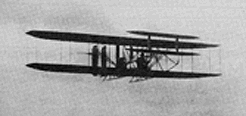Orville and Wilbur Wright are credited with making the first successful manned controlled powered flight on December 17th 1903. However, the Wright brothers did not start the process of making a heavier than air powered flight.
Sir George Cayley is considered the ‘grandfather’ of the plane. Cayley spent most of his adult life studying the principles of aerodynamics and he established the basic configuration of the modern fixed-wing plane. In 1853, he built and flew a full-size glider; it carried his less than willing coachman 200 metres.
Between 1853 and 1903, many others helped to develop Man’s knowledge about powered flight : William Henson, John Stringfellow, Clement Ader, Otto and Gustav Lilienthal and Professor Samuel Langley.
In 1896, the Wright brothers opened a bicycle shop in Dayton, Ohio. However, their real interest lay in flight. In 1899, they contacted the Smithsonian Institute requesting all the information the Institute had on flight. They read all they could about Cayley and the Lilienthal’s. They corresponded with a respected engineer called Octave Chanute.
In 1900, the brothers conducted their first full-scale tests on gliders near Kill Devils Hills on the coastal sand flats near Kitty Hawk, North Carolina. The area was specifically chosen as the American Weather Bureau told the brothers that the area had steady winds which averaged at no more than 13 mph.
By 1902, the brothers had made a glider that flew 188 metres – a record for the time. They gained valuable knowledge about the control of gliders in flight and the value of different wing shapes.
Their first plane – Flyer No 1 – had a wooden frame covered with cotton cloth. It measured just over 12 metres from wing tip to wing tip. The pilot was in the middle of the lower wing and to his right was a 12-horsepower petrol engine. The movement of the plane was controlled by a cradle attached to the pilot’s hips. When the pilot moved his hips, the cables attached to the wings would move thus moving the plane in flight.
Wilbur was at the controls for what should have been the first flight. However, the plane stalled on take-off. Orville won the toss of a coin to see who would be at the controls for the next test. At 10.35, December 17th, 1903, Orville flew for just 12 seconds. He covered a distance of 37 metres and rose to an altitude of 3 metres. Wilbur ran alongside Flyer No 1. Three more flights were made that day – the longest lasted 59 seconds and covered 260 metres.
What concerned the brothers was that people might see their flight as being essentially a glider flight as wind at Kill Devil Hills did play a major part. Over the next two years, the brothers built two planes that were engine powered and they flew them at Huffman Prairies near their home town of Dayton where there was little wind. From June to October 1905, they made more than 40 flights on Flyer III. One flight lasted 39 minutes and the plane reached speeds of 35 mph.

“Flyer” in action in 1908
The Wright’s were not two brothers who made bicycles and dabbled in the theory of flight as a pastime. They approached their work in a very scientific manner. They built the world’s first aero-engine which had the power-to-weight ratio of a modern family car. They also had to design their own propeller system as no previous one existed. Despite being confronted by scientific scepticism, they also flew their own machines as they wanted to know more about how a machine could fly – and what better way to do this than to be there yourself – i.e. actually in the flight. The whole project that revolutionised the world cost just $1000 – about £14,000 today.